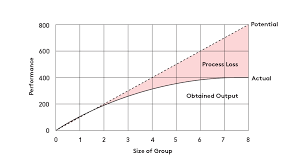We were all told that cooperation is the key to success since we were children. That if we all worked together we could achieve things that we would never have been able to achieve by ourselves. The recent scientific consensus however contradicts this notion that more people equals more work completed. So, which are we to trust modern science or tradition ?
Firstly, let’s talk about the recent data and scientist that came up with the theory that as the amount of people in a group that is working on the same goal increases the work done by singular person decreases. This theory was put forth by French agricultural engineer Max Ringelmann. He conducted several experiments on this topic the most famous one being the “tug of war” experiment. The way he directed this experiment was by observing 2 teams that were playing tug of war. First, he arranged a 2 player game of tug of war(there being 1 player on each side) his observations were that each player was trying their best to win. “100 % effort” as he put it. Then he observed a 4 player game of tug of war there being 2 players on each side this is where his observations deviated from the traditional idea that more people equaled more output. While the 2 player teams did try to win each player was only using about 90% of their potential. This trend of individual contribution to the team decreasing as the team grew in size. The graph given below were his findings. 
But why ? Why is this the case. Ringelmann believes that it is either one or a combination of these reasons :
1. Self and Social Loafing :
Social loafing refers to the concept that people are prone to exert less effort when working collectively as part of a group compared to performing a task alone. Social loafing is more evident in tasks where the contribution of each group member is combined into a group outcome, making it difficult to identify the contribution of a single person.
2. Communication Problems : This can be explained using a very helpful example. Imagine everyone in a room wanted to shake hands with everyone in a room. This would be a very easy task where there are only two people in a room. But in a room with 200 people this task would be nearly impossible to complete. The same thing can be said for team communication. As the group size increases communication gets more difficult.
This however does not mean that increased group sizes do not yield better total results. Of course more people means more total work. The thing just is the with every person that is added the productivity and communication skills decrease. Twitter is a good example of this. When Elon Musk bought Twitter the first thing he did was fire 50% of the employees working at Twitter. With this move he aimed to increase individual productivity and decrease communication problems.
It’s a good idea to keep this information in mind while also not forgetting the law of diminishing returns. The law of diminishing returns is a principle stating that profits or benefits gained from something will represent a proportionally smaller gain as more money or energy is invested in it. So the Ringelmann law only applies at large scales like cooperations and governments. So no, our ancestors were not wrong in saying “If we all don’t row, the boat won’t go.” Help and cooperation is key. Just don’t forget, too much of good thing can be detrimental.


